Attract More Online Car Buyers: Ways to Reach Buyers at Every Stage of the Buyer’s Journey
I’m sorry to have to say this: Your digital marketing is less and less effective every year. That’s not because you’re doing anything wrong, it’s more the fact that there are just more players coming into the game every month and that’s diluting the playing field.
And this isn’t anything new. Even in late 2014, Media Post found that “… ad budgets are up 17% [for the automotive sector]. Online media accounts for 95% of this year’s increase.”
As digital marketers, it’s your job to attract buyers that are shopping online, and as GMs, you have seen the impact that online media has on sales and the bottom line. However, with new players coming into the fold and existing dealers upping their investments, it will be increasingly difficult to reach car buyers with your dealership’s message.
One way to increase your message reach is to customize your marketing on different parts of the buyer’s path to purchase.
In 2012, Microsoft Advertising had created a report that identified the stages of a car buyer’s journey from the initial realisation of a need (or want) all the way beyond the purchase to ownership.
Each of these stages has a variety of media outlets and online information sources which are useful at each stage. Back in the day (or until just a few years ago) we marketers would have to rack our brains to determine the best time and place to display each ad. Fortunately, in today’s digital marketing age we can get extremely targeted with our messages and our content.
Thus, the ability to move from “educated guessing” to “data driven certainty”.
What we found missing from the stages that Microsoft had outlined is that car shoppers aren’t actively engaged in shopping 100% of the time. As a result, we need to add another dimension to these stages.
- Active Auto Shoppers
- Passive Auto Shoppers
Actively Shopping
Simply put, this is when shoppers are actively researching or looking for a vehicle.
Actively Researching
During this time, shoppers are looking at review, research and comparison sites to determine which car best fits their needs and wants.
Historically, one of the only methods to reach these buyers with your dealership message is through basic display advertising. Typically, this is a branding or offers strategy with messages that talk about financing or general dealer incentives.
However, in recent years, new inventory advertising products have been able to provide dealerships with the ability to show live dealership inventory during this stage to entice buyers to visit their website.
| Traditionally, the only way to get your dealership’s message out to car shoppers in the research phase was to promote a generic offer. | New inventory display advertisements now allow dealerships to show these buyers their actual inventory while they are researching. |
Actively Searching
During this time, car shoppers have selected the car, their car of the moment, and are then looking for where they can find one to test drive or evaluate in person.Reaching buyers during this mindset is relatively straightforward as people are actively looking for vehicles. As long as you have your inventory listed, and have a decent SEM campaign, you’re in the mix.
Traditionally, this is also where the bulk of the digital budget is spent. As a result, this stage is also where dealerships encounter the highest competition and see the most diminishing returns. As we mentioned above, the more players that come into the game, the less effective per dollar your digital marketing becomes.
Due to this oversaturation and highly competitive arena of listings and SEM, some savvy digital marketers have expanded into Inventory Display and other digital mediums to drive VDP traffic. Similar to listings advertising, Inventory Display feature interactive ads that link directly to your VDP to convert. However, unlike listings advertising and SEM, Inventory Display does not yet suffer from a high level of saturation and competition.
| Active car shoppers need a great SEM and listings campaign. | Inventory Display Ads are effective to attract shoppers at this stage but do not suffer from the high competition found in SEM and listings ads. |
Passively Shopping
During this time, car shoppers have stopped actively looking or researching the cars they want to buy. These people are going about their other browsing habits in other environments that are completely non-automotive.Typically, dealerships rely on retargeting or demographic targeting for this phase. However, retargeting only works if the buyer has gone to the dealership’s website and targeting by demographics paints everyone with a wide brush and may not be as effective as you think. A better method would be to combine retargeting from the dealer’s site and behavioral targeting based on the shoppers actual online auto browsing history, learned by a Data Management Platform (DMP) in the Active Stage. By doing this, you can deliver advertising that is relevant even in an environment that is not automotive specific.

Your message must be relevant to the consumer to be effective in the Passive Stage. Relevance can be achieved with behavioral targeting if they have not visited your website and retargeting methods if they have.
By having tactics to reach buyers at every stage, you will be able to increase your chances of attracting more car buyers to your website and ultimately help increase the sales of your dealership.







